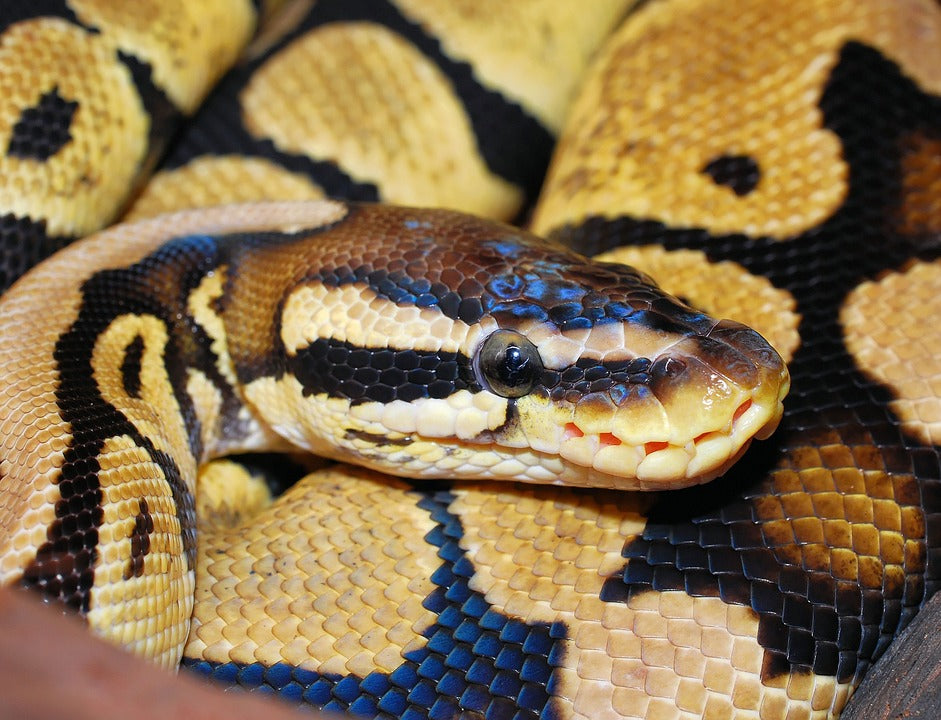Comparing Ball Pythons to Other Popular Pet Reptiles
Many reptile lovers consider ball pythons a fantastic first pet for many reasons. From their temperament, the minimal amount of care required compared to other pets, and their surprisingly long life span, it’s clear why the ball python has been able to acquire this reputation.
But how do ball pythons compare to other pet reptiles, such as tegus, hognose snakes, and bearded dragons? Should you get a ball python over these other creatures?
If you’re thinking about getting a ball python as a pet, you have to consider whether you can provide the proper care and handling. To demonstrate what I mean, let’s take a quick dive into what makes ball pythons and other animals unique, as well as what makes them great pets.
Keep reading to learn more about the personality traits, habitats, feeding habits, and required day-to-day maintenance for ball pythons and see how they stack up to other scaly friends!
Meet the Ball Python

Also known as the royal python (python regius), The ball python’s common name comes from its habit of curling up into a ball; they can be seen doing this in trees or under a rock. In the wild, ball pythons are commonly found in areas of West and Central Africa.
Size and Lifespan
The ball python adult can grow from 3 to 5 feet in length and can have a life expectancy of 20-30 years. Female ball pythons typically grow to be larger than adult ball python males. The reasons behind this sexual size dimorphism are fascinating, but all it means for the typical pet owner is that they should look for a female pet ball python if they want a big snake.
Morphs
Like most reptiles kept as pets, ball pythons have a large variety of morphs. Short for morphology, this refers to genetic variations that are specifically bred for their unique properties. The most popular morphs have unique patterns or bright colors, but some are more controversial than other.
For example, the spider ball python morph has a distinct pattern from which it derives its name. However, spider morphs also have a head wobble which has been classified as a genetic defect. If you’re interested in a specific morph for your pet snake, remember to research it thoroughly and only purchase them through a trusted breeder!
Bite
Speaking from experience, I can say that ball pythons have very cute faces. But if you’re the type of person who’s unsettled by snakes, there’s another distinguishing characteristic that might ease your fear:
Ball pythons are non-venomous snakes and don’t have fangs. Instead, they have hundreds of small teeth that are curved inward toward its mouth. They’re not like vipers, cobras, or mambas— as constrictors, they prefer “hugs” over “kisses.”
Obviously, it’s still painful to be bitten by hundreds of tiny teeth, but don’t worry— when you properly take care of one, a captive-raised pet ball python should never bite you. In fact, this is a huge reason why they’re so popular; ball pythons are known for being easy to handle if you respect their boundaries.
Diet
Ball pythons eat rats, mice, and sometimes small birds. Most ball python owners feed their pets mice or rats. Ball pythons need to eat their prey whole in order to obtain the correct balance of nutrients— although whole-prey links may be a decent substitute.

Although they eat wild prey in the wild, you shouldn’t feed a pet ball python anything wild-caught. Instead, go to a pet store and look for live or frozen prey. Once they start eating rodents of a larger size, some owners prefer to feed their pet frozen thawed rats/mice over live ones; this is in order to prevent the fully-grown creatures from scratching the snake and potentially causing an infection.
About every 4-6 weeks, ball pythons will shed their skin as they grow larger. It’s not uncommon for ball pythons to refrain from eating while shedding— but if they go even longer without food, you may want to investigate further.
Comparing Ball Pythons to Other Pet Reptiles
Now that you know more about the friendly ball python, you should have a better idea of whether or not you want one as a pet. But if you’re still on the fence, keep reading to see how they compare to other popular pet reptiles:
Ball Pythons vs. Tegus

The tegu is a large lizard that is known for its intelligence and friendly nature. In the wild, tegus can be found in Argentina, as well as other parts of South America like Brazil. They have even begun to recently appear in the wild in Florida, though this is thought to be due to irresponsible release of pet tegus into the wild.
- Diet: Tegus are opportunistic eaters and will eat almost anything— from fruits and vegetables to small birds and rodents. This makes them far easier to feed than ball pythons, who can be very picky about the size and temperature of their food.
- Intelligence: As members of the monitor family, tegus are big friendly pets with surprising cognitive abilities. Some owners will even train them like dogs; this isn’t possible with pythons, who are literal peabrains.
- Life Expectancy: They have half the lifespan of ball pythons, since they live between 12 and 15 years on average. However, their shorter life span makes them less of a commitment overall for first time pet owners than ball pythons.
- Size and Enclosure: They can grow to be 6 to 12 pounds and as long as 4.5 feet. This is much bigger than even a fully-grown female ball python— so it’s a bad pet choice if you live in a small apartment. Their tank and lighting situation also requires a bit more work than a ball python’s, but they can spend a lot more time outside of their enclosures.
Ball Pythons vs. Blue-Tongued Skinks

The blue-tongued skink is a non-picky eater and docile lizard. It almost looks like a snake with arms and legs due to its length (they can grow as long as 20 inches), but is most recognized for its bright blue tongue. Gardeners in Australia love this lizard for its appetite for snails and slugs.
- Activity: Blue-tongued skinks will only bite if they feel threatened, but otherwise are considered great pets for kids or first time pet owners. They’re also slightly more active than ball pythons, so they’re more popular with younger pet owners and children.
- Habitat: In captivity they require a gradient of temperature within their cages as well as a complete spectrum of UVA & UVB light for up to 12 hours per day. It’s important to keep a blue-tongued skink warm enough or it can increase its risk of getting sick.
- Diet: Skinks require a diet with a higher amount of variety than ball pythons. This makes them less picky with their food, but it also necessitates a balanced diet of fruits, veggies, and protein. For comparison, you only need to feed a ball python one rat or mouse every few days to a week.
- Size and Enclosure: At 2 feet long max, the blue-tongued skink’s size makes it larger than most lizards— but not ball pythons. That means you can keep it in more or less similar enclosures. However, the specific temperature requirements for BTS can be tougher to set up than a ball python’s.
Ball pythons vs. Hognose snakes

The hognose snake is considered one of the cutest beginner snakes due to its upturned pig-like snout. In the wild, these snakes can be found in North & South America, as well as Madagascar.
- Activity: Hognoses are known for their timid nature, preferring to hide from a fight in the wild or play dead to trick predators. Because of this, hognoses may be more resistant to handling, but it’s ultimately similar to caring for a ball python.
- Bite: Unlike ball pythons, hognose snakes have a venomous bite. However, it’s only harmful to smaller prey animals like frogs and mice; it’s not dangerous to humans.
- Diet: Hognose snakes can be picky eaters, especially if their temperature requirements for their housing aren’t followed correctly. However, they’re capable of subsisting on a more varied diet, including whole-prey links. Typically, hognoses start out eating crickets when smaller, but will graduate up to adult mice depending on how large they grow.
Ball Pythons vs. Bearded Dragons

Another pet native to Australia, bearded dragons are small, high-energy, and very cute. This makes them the most popular first-time pet, as do the fact that more than one can be housed in the same enclosure.
- Enclosure: Bearded Dragons are easy to care for. Their food is inexpensive (mostly crickets and veggies), and they love dry heat— so making a habitable enclosure for them is much easier.
- Cost: Between purchasing ball pythons and bearded dragons, it’s important to note the price difference, with a ball python running $40-$80 and the Bearded Dragon going for $30-$150. However, the monthly costs are roughly the same for both types of reptile.
- Life Expectancy: The Bearded Dragon lives from 8-14 years as opposed to the ball python’s 20-30 years. Both bearded dragons and ball pythons make great pets for first-time owners, but you’ll spend less time caring for beardies in the long run.
As you can see, there are benefits and drawbacks to ball pythons. I currently have one as a pet and can say with confidence that it’s a demanding but rewarding animal companion. Whatever pet you choose, make sure you’re prepared to care for it properly— after all, a healthy snake is a happy snake!

